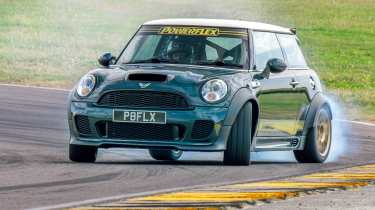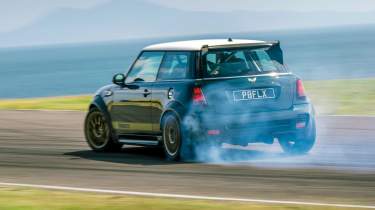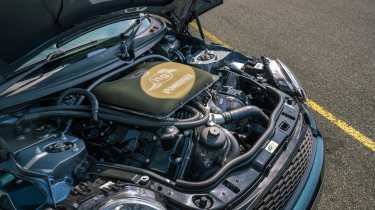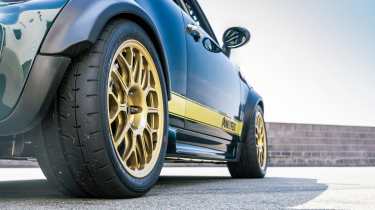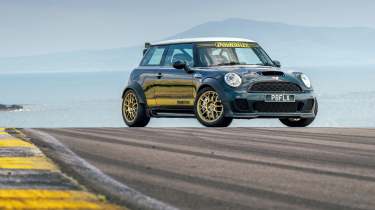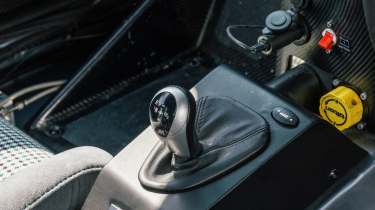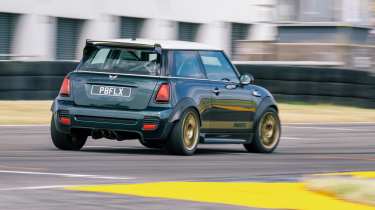Powerflex Mini V8 2025 review – driving a BMW M3-powered hatch
You haven’t seen a Mini dance like this before, but then you haven’t seen a Mini with a 4-litre M Power V8 under the bonnet and rear-wheel drive. Introducing Vini…
Whether it’s a manufacturer’s flight of fancy or a wild homebuilt special, the notion of slotting an oversized or unlikely engine into an equally unexpected host is a novelty that never fails to capture the imagination.
There have been some spectacular efforts over the years. You’ll doubtless recall Renault’s remarkable money-no-object V10-engined Espace F1. Likewise, BMW’s bonkers McLaren F1 V12-engined X5 Le Mans. Nissan GB’s one-off 350Z V6-powered Micra and Aston Martin’s more recent V8 Vantage-engined Cygnet are other prime examples, while US pro drifter Ryan Tuerck’s Ferrari 458-engined Toyota GT86 and Judd V10-engined Supra are iconoclastic indie outliers.
> BMW M3 GTS (E92, 2010-2011): review, history and specs of an icon
And now there’s ‘Vini’ to add to the Engine Swap Hall of Fame. Brainchild of Powerflex boss David Power, this wild V8 Mini is the result of almost six years’ hard graft and testament to the fabrication skills of Eliot Dunmore at EDM, who masterminded the build process.
‘It seemed like a good idea at the time,’ says Power with a smile when quizzed on what possessed him to embark on the project. Had he known it would take more than half a decade it’s doubtful he would have gone through with it, but seeing Vini being unloaded from its trailer in the paddock at Anglesey’s Trac Môn circuit we’re very glad he did.
More reviews
Group tests
- Alpine A290 v Alpine A110 – how much DNA do they really share?
- Ariel Atom 4R v Caterham Seven ‘evo25’: power-to-weight heroes go head-to-head
- Caterham Super Seven 600 v Super Seven 2000
- Levante v T1
- Corvette Stingray v Porsche Cayman GTS v Audi R8 RWD
- Great Ferrari hypercars driven: 288 GTO, F40, F50 and Enzo head-to-head
- Hardcore Ferrari V8 specials go head-to-head
- Lamborghini Aventador Ultimae v Lamborghini Countach
- Lotus Emira v Morgan Plus Four – four-cylinder Brits go head-to-head
- Toyota GR86 v BBR Mazda MX-5: supercharged drop-top battles sports coupe
In-depth reviews
- Abarth 600e 2025 review – Italy gives the Alpine A290 something to worry about
- Alpine A110 review – distinctive, lightweight and unforgettable to drive
- Audi R8 (2015 - 2024) review – the ultimate soft-focus supercar
- Bentley Continental R Mulliner: review, history and specs
- BMW 5-series review – is this still Munich’s anchor model?
- BMW 1-series review – Munich’s Audi A3 rival gains focus
Long term tests
- Abarth 695C Turismo Fast Fleet test – 10,000 miles in the Italian hot hatch
- Alfa Romeo Giulia Veloce Fast Fleet test – 7000 miles in the sharp Italian saloon
- Alpina B10: end of term report
- Alpina B10
- Ford Mustang GT
- Ford Mustang GT
- Ford Mustang GT
- Land Rover Defender 110 Fast Fleet test – 9000 miles in the go-anywhere SUV
- Maserati Ghibli Trofeo Fast Fleet test – 4000 miles in the Ferrari-powered saloon
- Mitsubishi Evo MR 340
Review
- New Aston Martin DBS 770 Ultimate review – 759bhp super-GT driven
- New Bentley Batur 2023 review – can it possibly be worth £1.65m?
- 2023 Chevrolet Corvette C8 Z06 review – the American 911 GT3?
- Kia EV6 GT-Line S prototype review – the EV that shows how it’s done
- BBR Supercharged Mazda MX-5 (ND) 2023 review – tuned 250bhp roadster driven
- MG4 Trophy 2023 review
Reviews
- Abarth 695 75 Anniversario edition 2024 review – a fitting send-off for Abarth’s hot supermini?
- Abarth 500e 2023 review
- AC Cobra 378 Superblower MkIV 2021 review – another V8 Cobra, but with a GM heart this time
- Acura Integra Type S 2024 review – a Honda Civic Type R with added restraint
- Alfa Romeo Giulia 2025 review – get one while you still can
- Alfa Romeo SZ: history, review and specs of an icon
- Alfa Romeo 1750 TBi
- Alpina B3 GT Touring 2025 review – a 190mph alternative to the BMW M3 Touring
The thought of an R56 Mini with a 4-litre V8 stuffed beneath the bonnet is almost too far-fetched to take seriously. Especially when that bonnet is unaltered. No extra bulges. No holes. Just a slightly larger air intake. It was clearly paramount to Power and Dunmore that Vini should give as few clues as possible to the crazy powertrain shoehorned inside. The end result is an extraordinary piece of deception.
Cosmetic modifications are best described as OE+, with just enough added muscle and attitude to pull your gaze while remaining sufficiently restrained that casual observers simply see a nice, dark green Cooper S. Of course, the clues are there if you know where to look: the fat, custom-made Braid rims, the wide-track suspension and the rear-drive stance that subtly sits the car over its haunches all send discreet signals that all is not as it seems. However, only when Vini’s M Power V8 gets fired into life is the explicit message broadcast loud and clear.
Mission creep goes with the territory with projects like this, but the journey to take Vini from concept to reality was unusually arduous. It began in late-2018, with Power approaching Dunmore to build him a fast Mini to enjoy on track. Things escalated quickly when Dunmore floated the righteous notion of rear-wheel drive. Confident he could build such a car, Dunmore suggested squeezing in a flat-four Subaru engine, compact and eminently tuneable, but Power wasn’t convinced. Conversation then pivoted to an S54 straight-six from the E46 M3, as it made a satisfying connection to the Mini’s BMW roots and promised a more exotic multi-cylinder experience.
It would have fitted (just), but then Power and Dunmore spoke to Iain Litchfield, who egged them on further by suggesting BMW’s S65 V8 might be more suitable. Once it was established that the V8 would fit like a hand in a glove the idea of a 400-plus bhp rear-drive M Powered Mini was born.
Then came Covid. Undeterred, Dunmore ploughed on in the splendid isolation of his workshop. Being two cylinders shorter meant the compact V8 actually presented fewer packaging issues than the longer in-line six. Still, Power’s insistence that crucial under-bonnet elements such as the cooling system, fluid reservoirs and intake system all had to be executed with the fit, finish and smart packaging of an OE build added to the challenge.
Dunmore had already identified that Subaru Impreza front and rear subframes, suspension arms, steering rack and anti-roll bars would fit a treat. With the BMW engine, gearbox and Impreza Spec C limited-slip diff for the rear axle already decided, attention then turned to positioning the fuel tank – a bespoke 90-litre F1-spec unit built by ATL – routing the exhaust system, calculating the space required for wheel travel, deciding on the springs, dampers and braking packages and designing the aforementioned cooling system.
It was here that Power’s long-standing connections with the UK’s tuning and specialist component manufacturing industries paid dividends. As founder of the Performance Aftermarket Automotive Association (a trade body for the UK aftermarket performance industry), Power’s project became something of a collective obsession, with key suppliers such as Forge Motorsport, Bilstein UK, ATL and Alcon all rolling up their sleeves to produce hardware to suit the exacting standards and unique requirements of the build.
For his part, Dunmore attacked Vini’s bodyshell in readiness for the transplanted powertrain and chassis hardware. The standard sills and chassis rails were kept, but the engine bay and mounts were reworked, along with the front and rear bulkheads, four bespoke strut towers and a large transmission tunnel. There’s also a new, braced and insulated two-layer honeycomb floor and a complex eight-point welded-in roll-cage that brings immense rigidity and criss-crosses the whole car. It’s an absolute masterpiece and testament to Dunmore’s ingenuity and engineering nous.
Everywhere you look there are beautiful CNC-machined parts, neat packaging solutions and clever engineering. For example, the Forge Motorsport radiator is 55 per cent larger than the original yet attaches to the same mountings. The ITG filter that sits atop the engine flows enough air to feed eight hungry combustion chambers yet is slim enough to fit beneath the bonnet. The firewall is sheathed in reflective gold foil and the fabulous custom exhaust system and catalyst sports have a Zircotec coating. It’s a proper job.
It’s strange to feel intimidated at the prospect of driving a Mini, but it’s impossible to second-guess what a 414bhp bhp wide-track, short-wheelbase rear-wheel-drive hatchback built from a blend of Mini, BMW and Subaru components is going to feel like. As ever, there’s only one way to find out.
The answer is a somewhat discombobulating mash-up of familiar yet totally out-of-context visual, aural and tactile cues. What you walk up to very definitely roots you in all your previous experience of driving hot Minis, but once settled behind the steering wheel (complete with AIM shift lights and data display) all that goes straight out of the window. The stubby DCT selector and dinky paddleshifters prepare you for an E92 BMW M3. As does the engine, which starts with the unmistakable metallic snarl of M Power’s fabulous 4-litre V8. It really is a case of love at first throttle blip.
Much of the interior is bespoke. The neat array of switches creates a race-car vibe, but the beautifully trimmed Cobra seats and unique moulded carbonfibre door cards (made by Dunmore, who taught himself how to work with carbon) bring a welcome and unexpected sense of luxury and craft to the otherwise bare-bones interior. It’s a fine showcase for the collective capabilities of the UK tuning scene.
With little in the way of trim, all of Dunmore’s fabrication skills are on show. If you appreciate the expertise required to cut, shape and weld metal to immaculate standards, you’ll be mesmerised. With so much metal stitched together it could easily have looked like Frankenstein’s monster, but no matter what nook or cranny you scrutinise, everything looks absolutely mint.
The V8 fills the cockpit with a truly magnificent noise. It’s loud of course, but not race-car raw. It wouldn’t be unreasonable to expect such an over-engined one-off special to resonate horribly, but there’s a welcome absence of unpleasant NVH. Hats off, then, to Power’s business, Powerflex, for making all the mounts and bushes for the suspension, engine and transmission.
Thanks to the DCT transmission Vini is a pussycat to operate. Just dab the brake, slot the short selector lever into D, nudge it to select M for manual mode, then pull away. The standard M3 shift-speed adjuster has been carried over, so you can dial-in sharper gearchanges. The overall shift quality isn’t quite as sharp as an M3’s, but there’s still scope to refine the control mapping via the SYVECS programmable ECU.
Even as it stands, Vini is more than slick enough through the gears, though the Subaru Spec C diff and final drive means the gearing is shorter than you might expect. It all adds to the melting pot of sounds, feel and response you get from this unique blend of hardware. Straight-line acceleration is enough to make you catch your breath, the 1300kg Mini propelled by the high-revving V8 with addictive intensity. To fully unlock the driving experience you need to think a gear or two higher for every corner. With seven speeds there are plenty to choose from, and once you’ve accepted that some of the tighter corners can be taken in third or even fourth, the rewards are rich.
The soundtrack is absolute bliss. A fabulous mix of bellowing induction and musical V8 exhaust howl, it just gets better and better with rpm and load. Later, when evo colleague James Taylor has a few laps, I’m treated to the one thing you’re denied from the driver’s seat. That’s to say the surreal experience of seeing a Mini but hearing a barely silenced E92 M3. The way it punches between the corners looks like speeded-up video footage, which only adds to the amusement and incredulity.
Unsurprisingly you need time to get dialled-in to how Vini drives, accepting the fact that it doesn’t react to your inputs like a front-drive hot hatch. It’s been years since I’ve driven an STI Impreza, but Vini’s steering takes me right back. It’s not darty, in fact the front-end is surprisingly calm on initial turn-in. Probably just as well given the broad track and short wheelbase. I’d like a fraction more feel (it was always thus in Imprezas), but Vini is amazingly stable, with plenty of grip to lean on and a faithful balance to inspire confidence.
The Alcon brakes – huge 343mm diameter discs all-round, clamped by six-piston calipers at the front and four-piston at the rear – have more than enough stopping power. They also feature programmable Bosch Motorsport ABS, so you can hit them hard and deep into the corners if you need to. The pedal is good and firm too, thanks to Goodridge braided hoses and a rock-solid, beautifully made Tilton pedal box. In this regard Vini’s race-car pedigree comes to the fore.
Our first run reveals the suspension is a bit too stiff for Anglesey’s tighter corners, but once Dunmore has made some adjustments to the three-way Bilstein dampers Vini really finds its feet, powering cleanly through the twists and turns and getting increasingly playful as my steering and throttle inputs become more attuned to the car’s needs.
What’s really impressive is that it feels equally happy being hustled like a race car or provoked into big smoky slides. It’s also fun and engaging at any stage in between, which makes it just about perfect for trackdays, which was Power’s goal right from the beginning, though it is fully road-legal too.
With each run I get more confident with what Vini is going to do. Carry too much speed into a corner and settling understeer calms things down without any nasty lift-off behaviour, but judge things just right and the balance is beautifully neutral, transitioning into readily held oversteer. How much depends on whether you overcome the rear end’s traction from apex to exit with increasing throttle opening, or lift just as you turn in to transfer weight onto the nose, then pick up the throttle nice and early for a long (and I mean l-o-n-g) drift. The novelty of doing this in a Mini never wears off. Which is more than can be said for the tread on the rear tyres…
Power is understandably coy about revealing just how much he spent realising his vision. Whatever the number is (and let’s face it, we all know it’s going to be a big one) he’s clearly completely smitten and grins from ear-to-ear whenever he talks about Vini, drives it, or sees it being driven.
Given the propensity for projects of this nature to turn into nightmares, it’s heartening to see him conquer what most would see as insurmountable engineering challenges. It takes a special kind of madness to embark on an engine swap of this magnitude. Kudos to Power and his cadre of co-conspirators for creating a Mini like no other. Vini, vidi, vici.
Powerflex Mini V8 specs
| Engine | V8, 3999cc |
| Power | 414bhp @ 8300rpm |
| Torque | 295lb ft @ 3900rpm |
| Weight | 1300kg |
| Power-to-weight | 324bhp/ton |
| 0-62mph | c4.0sec (est) |
| Top speed | c150mph |
This story was first featured in evo issue 326.
